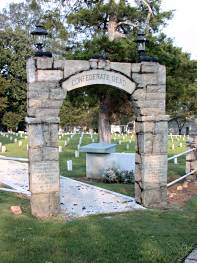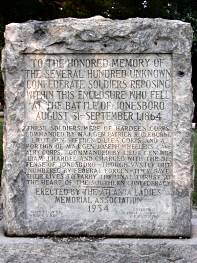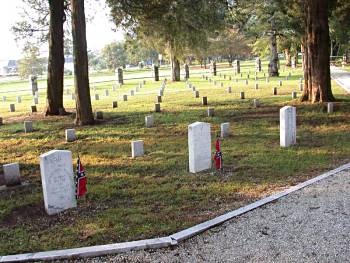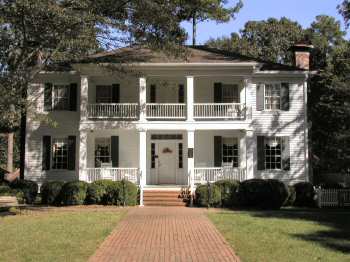|
From 1830 until
the late 1850's the building known as the Stage Coach Inn of Palmetto, or
the Griffis House served as an overnight Inn for travelers, and as a tavern.
When the railroad was built through Palmetto and the city of Atlanta was
formed, this house remained as an Inn although stagecoaches ceased
operations. During the Civil War the house took on the responsibility of
being the local Confederate Post Office as well as an Inn.
During the Atlanta Campaign of 1864, Northern Calvary troops raided Palmetto
and burned the railroad station and City Hall. However, the Stage Coach Inn
was about one mile north of the railroad station and in their haste to avoid
the pursuit of the confederate forces, The Northern Calvary missed this
building altogether.
After the fall of Atlanta, the Confederate forces regrouped in mass in
Palmetto to await orders as to the next battle plan. As a result of a state
of emergency in Georgia, the President of the Confederate States of America,
Jefferson Davis, traveled to Palmetto to meet with the head of the
Confederate Army of Tennessee, General John Bell Hood, and the governor of
Georgia, Joseph Brown. This meeting which took place on September 25, 1864
is know as the Palmetto Conference. Because the city hall and train depot
had been burned down, the meeting took place in the next logical place which
was the Stage Coach Inn. The meeting was of great importance to the
Confederacy and to the State of Georgia.
Jefferson Davis wanted to persuade Governor Brown to remain in the
Confederacy and to release the Georgia Militia to the Confederate Army.
Additionally the conference was held to determine how to strike back at
Sherman's army which was resting in Atlanta. In the meeting in this building
it was decided that the plan of attack would be to cut off Sherman's supply
line to the North thus placing his army in extreme hardship in Atlanta and
forcing an evacuation of the city.
After the meeting President Davis spoke to the troops from the front porch
of this building in an effort to boost morale. The irony of the Palmetto
Conference is that it actually hastened the end of the war because the
strategy did not work. When Sherman realized his lines had been cut along
the railroad to the North, he made the decision to march to Savannah and the
Army would live off the land as they moved. After the long hard struggle to
take Atlanta, Sherman was not about to turn it back to the Confederates so
he burned the city. Thus the ill-fated decision by the Confederates at the
Palmetto Conference was directly in relation to the burning of the city of
Atlanta and therefore the place of this decision, the Stage Coach Inn of
Palmetto, is of great historical importance even though relatively unknown
to the general public today.
Courtesy of Tim Barclay, GA |







